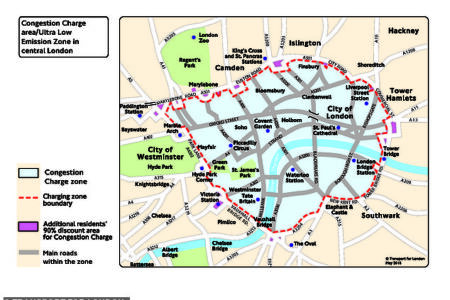- Leaked proposals show road pricing plan was almost confirmed for 2026
Sadiq Khan planned to charge drivers £2 per mile to drive in central London, leaked proposals show.
The nearly implemented plan was almost brought in for September 2026, to be the headline policy of the mayor’s final term.
If it had gone through it’s likely it would have proved one of the most controversial motoring schemes in recent history.

Sadiq Khan planned to charge drivers £2 per mile to drive in central London from September 2026, leaked proposals show.

Seen and revealed by London Centric, the leaked plans show that London’s Mayor and TfL plotted to charge motorists up to £2 per mile to drive inside the Congestion Charge zone, as well as whacking them with a £5 daily tax.
‘Project Gladys’, as it was internally codenamed, modelled how the pay-per-mile move would lead to a drastic reduction in the number of cars on the roads.
Leaked plans reported by London Centric show that London’s Mayor and TfL plotted to charge motorists up to £2 per mile to drive inside the Congestion Charge zone, as well as whacking them with a £5 daily tax.
Under the proposals – in which prices weren’t finalised – the original Ultra Low Emission Zone, ‘Inner London’, was likely to get a pay-per-mile charge of 60p per mile. The rest of Greater London would have a 40p per mile fee.
According to London Centric, the eye watering amounts motorists were expected to pay under the ‘Next Generation Charging’ scheme were modelled by TfL.
Driving a ULEZ compliant car across ‘inner London’ on a 30-mile return trip from Highgate to Fulham would have cost the motorist £18 in pay-per-mile taxes.
Currently it costs just the amount a driver spends on fuel.
A return from Upminster to Oxford Circus would have risen from £15 to a massive £40 under the proposed changes.
The effect on London traffic levels would have been drastic, with London Centric claiming the modelling showed 600,000 fewer car trips, 170,000 extra bus journeys and 210,000 trips on foot would have been made.
In September of this year, Sadiq Khan categorically ruled out bringing in the radical tax system
The implementation process was also road mapped in the leaked documents, with an initial trial period followed by public consultations throughout 2024.
In 2025 London signage would have been replaced, and then in September 2026 the full pay-per-mile scheme would have been enforced.
London Centric reported that until late 2023 ‘with the mayor’s backing, TfL was pressing ahead with development of the plan, having already invested millions of pounds in the project and the required technology’
But then in September, Sadiq Khan categorically ruled out bringing in the radical tax system.
Speaking to the London Assembly Mr Khan said: ‘I want to be crystal clear. A pay-per-mile scheme is not on the table and not on my agenda. I will not move the goalposts on ULEZ emission standards.’
Protesters opposed to the expansion of London’s Ultra Low Emissions Zone demonstrate outside BBC Broadcasting House on July 22, 2023, in London
According to London Centric the reason for the multi-million pound U-turn was the strong opposition in the run-up to the mayoral election, where Sadiq Khan was accused of creating a ‘war on motorists’.
The ‘Project Gladys’ revelation comes after the Chancellor refused to introduced pay-per-mile tax in the Budget, despite pressure to introduce the new road pricing system to replace conventional motoring taxes UK-wide.
Latest recommendations suggest it could generate an £30billion in cashflow for the economy and reduce congestion on the busiest routes.
Pay-per-mile: What is it?
As the name suggests, pay-per-mile road tax would see drivers pay tax based on the number of miles they drive.
The further you drive, the more you pay.
It would replace the current VED system or ‘road tax’, which taxes a vehicle depending on vehicle type, age, fuel type and – crucially – its measured CO2 emissions. Higher polluting vehicles are taxed a higher rate of VED.
Iceland and New Zealand already have a pay-per-mile tax policy in place.
How popular or unpopular is national pay-per-mile?
Go Compare surveyed 2,000 drivers in December 2023, with just over half (53 per cent) voting against a pay-per-mile tax system.
Unsurprisingly, 52 per cent said they opposed the scheme because they felt it would be unfair to vehicle owners who are more reliant on their motors – especially those living in rural and remote areas.
Young motorists were the most against it – 60 per cent of 18 to 24-year-olds felt this way.
Contrastingly, among the quarter (26 per cent) of respondents who’d welcome pay-per-mile, it was mainly older drivers aged 55 and over (one third).
Of the 26 per cent who said they’d back the switch, 76 per cent thought it would make for a fairer system.
The next most popular reason was the positive effect it would have on minimizing unnecessary car usage, reducing congestion and emissions – 59 per cent voted for this.
Some 44 per cent said they’d be pro it because they’d pay less tax.
While this might seem fair to some drivers, there are stark warnings about how unfair it will be for rural drivers who have no choice but to drive further.


